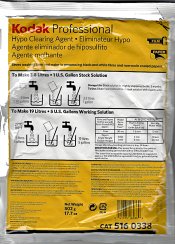NB23
Member
- Joined
- Jul 26, 2009
- Messages
- 4,307
- Format
- 35mm
Okay, another stupid question. Actually, not so stupid but rather Kodak’s shady information is driving me nuts.
On the Hypo clearing agent Bag, it says that the capacity of One Gallon of HCA is good for up to 200 8x10 prints.
Now, are they refering to One Gallon of
STOCK SOLUTION? Or One Gallon of WORKING SOLUTION (diluted at 1+4)?? That’s 200 versus 1000 prints difference right there.
I’ve always been using it very conservatively, however now my stock is running low and I need to know the exsct info. There is no way of testing the stuff so I have to go with the theory.
kodak is not helping. Can Kodak fire that dude in charge of (mis)informing people like us?
thanks
On the Hypo clearing agent Bag, it says that the capacity of One Gallon of HCA is good for up to 200 8x10 prints.
Now, are they refering to One Gallon of
STOCK SOLUTION? Or One Gallon of WORKING SOLUTION (diluted at 1+4)?? That’s 200 versus 1000 prints difference right there.
I’ve always been using it very conservatively, however now my stock is running low and I need to know the exsct info. There is no way of testing the stuff so I have to go with the theory.
kodak is not helping. Can Kodak fire that dude in charge of (mis)informing people like us?
thanks













